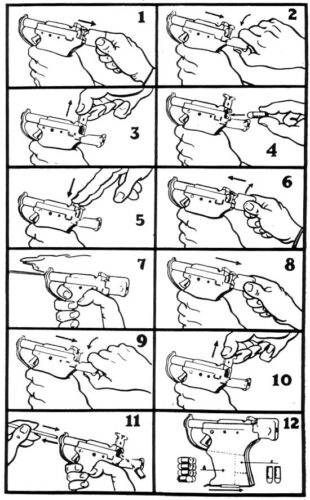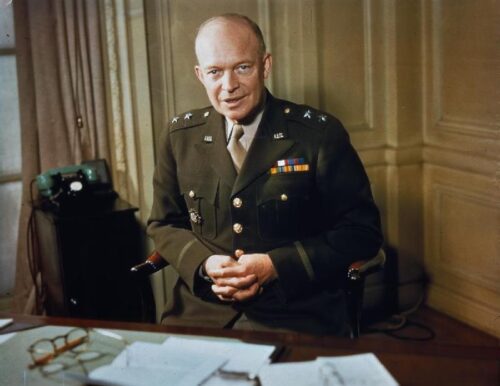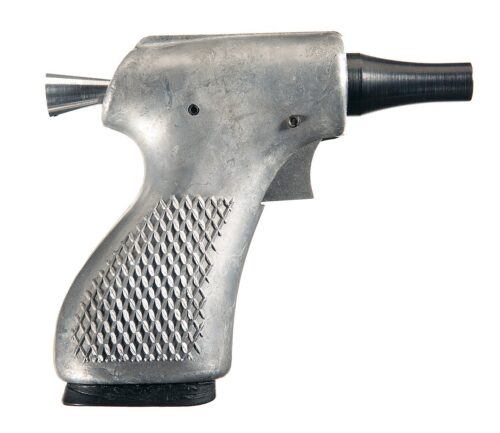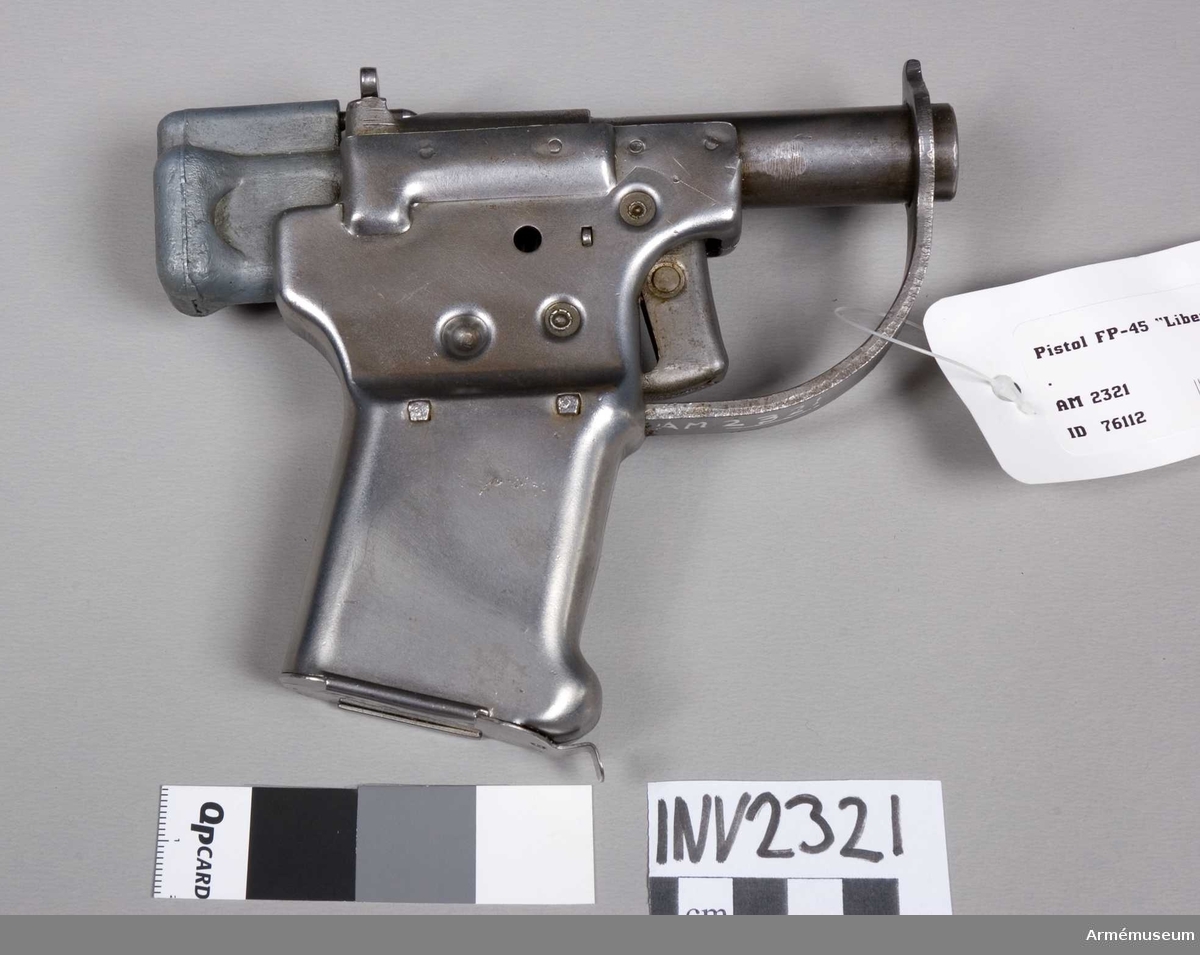FP-45 Liberator. Photo: Armémuseum / CC BY 4.0 DEED.
The FP-45 Liberator was a unique weapon developed during World War II by the United States. It was a single-shot handgun designed to be used by resistance forces in occupied territories. The FP-45 was never issued to American or other Allied troops, and there are few documented instances of the weapon being used for its intended purpose.
Design and Production
The FP-45 was a crude, single-shot pistol designed to be cheaply and quickly mass-produced. It had just 23 largely stamped and turned steel parts that were cheap and easy to manufacture. It fired the .45 ACP pistol cartridge from an unrifled barrel. Due to this limitation, it was intended for short-range use, 1–4 yards (0.91–3.66 m). Its maximum effective range was only about 25 ft (7.6 m)1. At longer range, the bullet would begin to tumble and stray off course. Five rounds of ammunition could be stored in the pistol grip.
The FP-45 Liberator was designed by George Hyde, who was an engineer for the Inland Manufacturing Division of the General Motors Corporation in Dayton, Ohio. The design was completed in May 1942 and was intended for the United States Army. The project was assigned to the US Army Joint Psychological Warfare Committee. The idea seems to have originated with a Polish Military Attaché in March of 1942. The “FP” officially stood for flare pistol.to disguise its real purpose.
Approximately 1,000,000 FP-45 Liberator pistols were produced. The production was handled by the Guide Lamp Division of General Motors Corporation in Anderson, Indiana. The production run lasted for about three months, from June 1942 to August 1942.
The original delivered cost for the FP-45 was USD $2.10/unit (equivalent to $39.58 in 2024), lending it the nickname “Woolworth pistol”. The FP-45 was delivered in a cardboard box that included ten .45 ACP rounds. It also came with a wooden dowel for ejecting spent cartridges, and a set of instructions presented in a cartoon-like format that demonstrated the loading and firing procedures.

Distribution and Use
The FP-45 was intended to be air-dropped to resistance fighters in occupied territories. The staff of General Dwight D. Eisenhower, the Supreme Commander of the Allied Forces in Europe, didn’t see the practicality of airdropping the Liberator en masse over occupied Europe. Theater commanders weren’t keen on having hundreds of thousands of uncontrollable little guns wandering around their post-war zones of occupation. Relatively few were issued. As a result, they authorized the distribution of less than 25,000 out of the half a million FP-45 pistols that were shipped to Great Britain for the French resistance.

Generals Joseph Stilwell and Douglas MacArthur shared similar sentiments about the remaining half of the pistols that were scheduled for shipment to the Pacific. Consequently, the Army handed over 450,000 Liberators to the Office of Strategic Services (OSS), which preferred to equip Resistance fighters in both theaters with more effective weapons whenever possible.
While the use of the FP-45 by the French remains undocumented, there is a first-hand account of an assassination with an FP-45 from a German military policeman named Niklaus Lange. He asserted that thousands of these weapons were in circulation in occupied France. The OSS did distribute a few to Greek resistance forces in 1944. However, most of the pistols shipped to Britain remained undistributed and were later discarded at sea or melted down for scrap metal.
In 1943, one hundred thousand FP-45 pistols were shipped to China, but the actual number distributed remains a mystery. A small number were distributed to the Philippine Commonwealth Army, the Philippine Constabulary, and resistance fighters.
CIA Deer Gun
Two decades after the creation of the FP-45 Liberator, the concept of an inexpensive, easily produced clandestine firearm was revived by the Central Intelligence Agency (CIA). This occurred during the initial stages of the Vietnam conflict. The new iteration of the weapon was referred to as the “deer gun”, bearing a striking similarity to its predecessor, the FP-45. The deer gun, however, had a few modifications. It was chambered in 9x19mm.
As the production of the deer gun commenced, the first production run yielded about 1,000 units. However, the geopolitical landscape was rapidly changing. Initially, the Vietnam conflict was envisioned as a small covert war where the deer gun could have been highly useful. The Vietnam conflict had escalated from a regional dispute into a full-scale war. This shift in the nature of the conflict rendered the deer gun less relevant. Sime deer guns were evaluated in Vietnam, but the number is not known.
In response to these changing circumstances, the CIA made the decision to conceal the deer gun project. Orders were issued for the destruction of the deer guns that had been produced. This directive was carried out with such thoroughness that today, fewer than 20 deer guns are known to exist. This scarcity makes the deer gun a rare and intriguing artifact of a pivotal time in history.

In Conclusion
The FP-45 Liberator stands as a remarkable piece of history from World War II. Its unique design, mass production, and intended use by resistance forces in occupied territories underscore the desperate and innovative measures taken during the war. While its actual use in combat may have been limited, the Liberator’s very existence and the strategy behind its distribution speak volumes about the geopolitical landscape of the time. The FP-45 Liberator, though a simple and crude weapon, holds a significant place in the annals of military history.
Resource
Central Intelligence Agency
CIA.gov
*The views and opinions expressed on this website are solely those of the original authors and contributors. These views and opinions do not necessarily represent those of Spotter Up Magazine, the administrative staff, and/or any/all contributors to this site.

